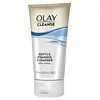What's inside
What's inside
 Key Ingredients
Key Ingredients

No key ingredients
 Benefits
Benefits

 Concerns
Concerns

 Ingredients Side-by-side
Ingredients Side-by-side

Water
Skin ConditioningGlycerin
HumectantSodium C14-16 Olefin Sulfonate
CleansingLauryl Hydroxysultaine
CleansingSorbitol
HumectantAcrylates Copolymer
Polyglyceryl-4 Caprate
EmulsifyingPolyglyceryl-6 Caprylate
EmulsifyingParfum
MaskingChamomilla Recutita Flower Extract
MaskingCitrus Tangerina Extract
TonicCitrus Tangerina Peel
AbrasiveCitrus Aurantium Amara Flower Water
MaskingHippophae Rhamnoides Fruit Extract
Skin ConditioningZingiber Officinale Root Extract
MaskingGlycyrrhiza Glabra Root Extract
BleachingMalt Extract
Skin ProtectingSodium Hyaluronate
HumectantHyaluronic Acid
HumectantHydrolyzed Hyaluronic Acid
HumectantAscorbic Acid
AntioxidantSodium Chloride
MaskingEthylhexylglycerin
Skin ConditioningButylene Glycol
HumectantPropanediol
SolventPotassium Hydroxide
BufferingPropylene Glycol Laurate
Skin ConditioningDecyl Glucoside
CleansingCoco-Glucoside
CleansingPotassium Benzoate
PreservativeTrisodium Ethylenediamine Disuccinate
Citric Acid
Buffering1,2-Hexanediol
Skin ConditioningCI 19140
Cosmetic ColorantLinalool
PerfumingCitronellol
PerfumingGeraniol
PerfumingWater, Glycerin, Sodium C14-16 Olefin Sulfonate, Lauryl Hydroxysultaine, Sorbitol, Acrylates Copolymer, Polyglyceryl-4 Caprate, Polyglyceryl-6 Caprylate, Parfum, Chamomilla Recutita Flower Extract, Citrus Tangerina Extract, Citrus Tangerina Peel, Citrus Aurantium Amara Flower Water, Hippophae Rhamnoides Fruit Extract, Zingiber Officinale Root Extract, Glycyrrhiza Glabra Root Extract, Malt Extract, Sodium Hyaluronate, Hyaluronic Acid, Hydrolyzed Hyaluronic Acid, Ascorbic Acid, Sodium Chloride, Ethylhexylglycerin, Butylene Glycol, Propanediol, Potassium Hydroxide, Propylene Glycol Laurate, Decyl Glucoside, Coco-Glucoside, Potassium Benzoate, Trisodium Ethylenediamine Disuccinate, Citric Acid, 1,2-Hexanediol, CI 19140, Linalool, Citronellol, Geraniol
Water
Skin ConditioningGlycerin
HumectantSodium Myristoyl Sarcosinate
CleansingPEG-120 Methyl Glucose Dioleate
EmulsifyingSodium Lauroamphoacetate
CleansingPEG-150 Pentaerythrityl Tetrastearate
EmulsifyingSodium Trideceth Sulfate
CleansingSodium Laureth Sulfate
CleansingGlycol Distearate
EmollientPolyquaternium-10
Phenoxyethanol
PreservativeCitric Acid
BufferingCocamide Mea
EmulsifyingDisodium EDTA
DMDM Hydantoin
PreservativeAloe Barbadensis Leaf Extract
EmollientWater, Glycerin, Sodium Myristoyl Sarcosinate, PEG-120 Methyl Glucose Dioleate, Sodium Lauroamphoacetate, PEG-150 Pentaerythrityl Tetrastearate, Sodium Trideceth Sulfate, Sodium Laureth Sulfate, Glycol Distearate, Polyquaternium-10, Phenoxyethanol, Citric Acid, Cocamide Mea, Disodium EDTA, DMDM Hydantoin, Aloe Barbadensis Leaf Extract
 Reviews
Reviews

Ingredients Explained
These ingredients are found in both products.
Ingredients higher up in an ingredient list are typically present in a larger amount.
Citric Acid is an alpha hydroxy acid (AHA) naturally found in citrus fruits like oranges, lemons, and limes.
Like other AHAs, citric acid can exfoliate skin by breaking down the bonds that hold dead skin cells together. This helps reveal smoother and brighter skin underneath.
However, this exfoliating effect only happens at high concentrations (20%) which can be hard to find in cosmetic products.
Due to this, citric acid is usually included in small amounts as a pH adjuster. This helps keep products slightly more acidic and compatible with skin's natural pH.
In skincare formulas, citric acid can:
While it can provide some skin benefits, research shows lactic acid and glycolic acid are generally more effective and less irritating exfoliants.
Most citric acid used in skincare today is made by fermenting sugars (usually from molasses). This synthetic version is identical to the natural citrus form but easier to stabilize and use in formulations.
Read more about some other popular AHA's here:
Learn more about Citric AcidGlycerin is already naturally found in your skin. It helps moisturize and protect your skin.
A study from 2016 found glycerin to be more effective as a humectant than AHAs and hyaluronic acid.
As a humectant, it helps the skin stay hydrated by pulling moisture to your skin. The low molecular weight of glycerin allows it to pull moisture into the deeper layers of your skin.
Hydrated skin improves your skin barrier; Your skin barrier helps protect against irritants and bacteria.
Glycerin has also been found to have antimicrobial and antiviral properties. Due to these properties, glycerin is often used in wound and burn treatments.
In cosmetics, glycerin is usually derived from plants such as soybean or palm. However, it can also be sourced from animals, such as tallow or animal fat.
This ingredient is organic, colorless, odorless, and non-toxic.
Glycerin is the name for this ingredient in American English. British English uses Glycerol/Glycerine.
Learn more about GlycerinWater. It's the most common cosmetic ingredient of all. You'll usually see it at the top of ingredient lists, meaning that it makes up the largest part of the product.
So why is it so popular? Water most often acts as a solvent - this means that it helps dissolve other ingredients into the formulation.
You'll also recognize water as that liquid we all need to stay alive. If you see this, drink a glass of water. Stay hydrated!
Learn more about Water